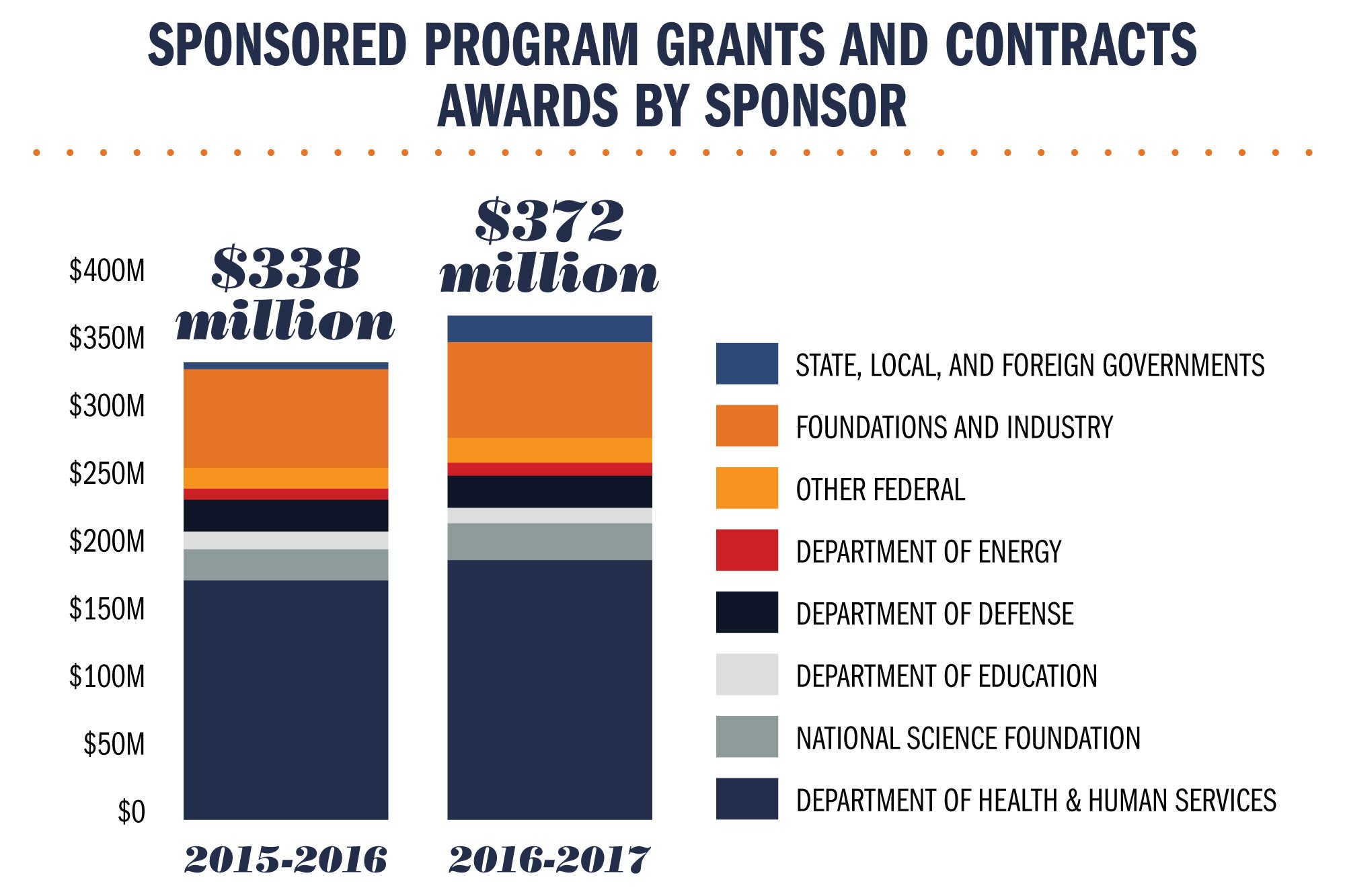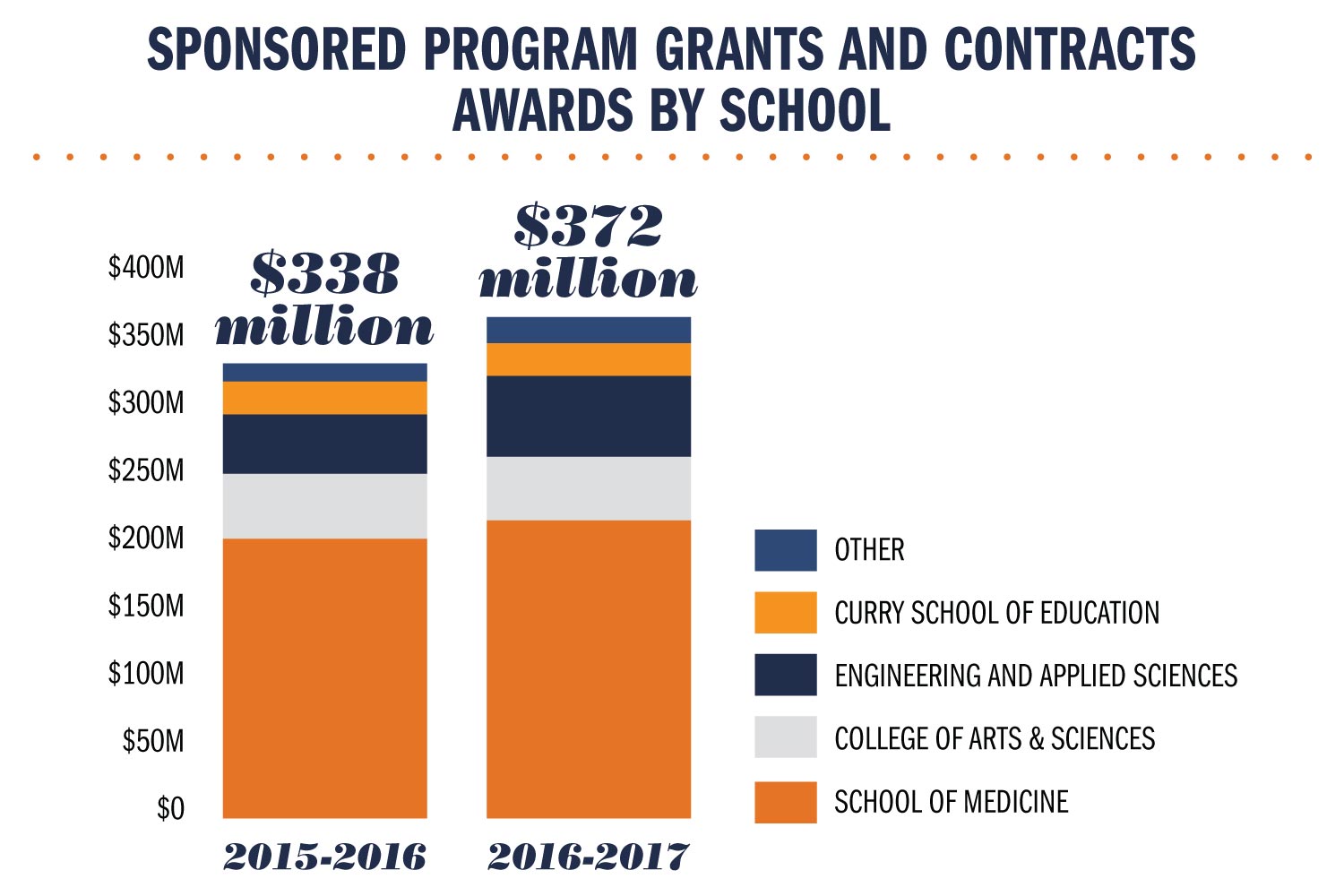As the University of Virginia strategically invests in expanding and enhancing its research enterprise, with the goal of doubling by 2022 the sponsored programs base from 2015 levels – the payoff is becoming apparent.
Sponsored research funding has increased for four consecutive years – including 10 percent during the 2016-17 fiscal year, to a total of $372.4 million. In 2015-16, sponsored funding was at $338 million – up 8 percent from the previous year.
“We’re on track to meet audacious institutional growth goals in research funding,” said Elizabeth Adams, assistant vice president for research administration in the Office of Sponsored Programs. “The University’s comprehensive strategy to increase the volume and diversity of research funding is proving sound.”
This year, the University is bringing in $282 million from the federal government (76 percent of the total and a 9 percent increase over last year); nearly $71 million from nonfederal sources, including foundations and industry (19 percent of total funding); and more than $19 million from state, local and foreign governments (approximately tripling funding in this category relative to the previous year’s total).
The biggest single funding source – $191 million – is from the Department of Health and Human Services, which includes the National Institutes of Health, the leading funder of medical research. The National Science Foundation provides more than $27 million of the University’s sponsored funding; the Department of Defense funds nearly $24 million; the Department of Education covers more than $11 million; and the Department of Energy provides $9.5 million. Other federal agencies award more than $18 million in grants and contracts.

Research funding, by source
In partnership with the University’s 11 schools, UVA President Teresa A. Sullivan, Executive Vice President and Provost Thomas C. Katsouleas, Executive Vice President for Health Affairs Dr. Richard P. Shannon and the UVA Board of Visitors have in recent years committed resources toward research infrastructure improvements and faculty recruitment and retention.
“I am excited about the direction research is headed and the momentum that has been generated at the University,” said M.K. (Ram) Ramasubramanian, UVA’s new vice president for research, appointed in February. “In collaboration with the senior leadership and schools, and with Board of Visitors support, UVA is well-positioned to continue its growth in research and strengthen its position as a world-class, premiere research institution. The future is bright and I look forward to partnering with my colleagues across Grounds to move the research vision forward.”
The Board of Visitors’ Strategic Investment Fund is supporting multi-disciplinary and multi-school research initiatives, as well as infrastructure support, such as for computing and capital equipment, among other initiatives to enhance the research/education connection at the University. With the Strategic Investment Fund, the University also has created modern laboratory spaces, while increasing support staff and investing in an internally developed software platform, ResearchUVA, designed to efficiently transact business and analyze data related to sponsored programs.
“These SIF investments are designed to enhance the University and to bring in new funding from multiple sources for societally important research,” said Jeffrey Blank, associate vice president for research. “Along with medical and engineering research, we are looking to include the humanities, social sciences and the arts. We want to be proactive, looking ahead to where new collaborative opportunities lie.”

Research revenue, by school.
One way to promote and expedite this effort runs through UVA’s Data Science Institute, established three years ago as part of the Cornerstone Plan. The institute facilitates multidisciplinary, data-intensive studies across schools and in conjunction with other institutes and centers that bring understanding to how complex systems work, such as the ways societies interact with environments and each other.
The University’s investment also includes “cluster” hires of faculty members who can tap into a range of funding sources through their ability to collaborate across academic units and fields.
“Increasingly, research funding is awarded to teams of researchers working together to tackle big problems that cannot be studied by individuals working alone,” Blank said. “By broadening our scope and putting together teams of researchers, we can become highly competitive in a hyper-competitive national funding environment. Increasingly, we also are teaming up with other institutions in the commonwealth, sharing resources, to increase research capacity.”
Two years ago, the Office of the Vice President for Research established ResearchNet, a cross-Grounds initiative to assist faculty in developing research collaborations and in discovering external funding opportunities. ResearchNet also provides support for proposal preparation on large, multidisciplinary projects.
“Seed funding mechanisms at the University allow researchers to strengthen their internal collaborations and develop preliminary data to strengthen extramural funding applications,” Adams said. “We’re also working on institutional strategy to diversify our nonfederal and federal portfolios, including the Department of Defense, the Department of Energy, and the Department of Transportation. And we’re trying to encourage all schools, centers and institutes to play a larger role in the research mission of the University.”
The strategy includes the recent establishment of three new pan-University institutes, each of which leverages the Data Science Institute’s resources – the UVA Brain Institute, devoted to multi-faceted explorations into the workings of the brain and its diseases; the Global Infectious Diseases Institute, which is delving into ways to alleviate the spread of infectious diseases; and the Environmental Resilience Institute, which takes multi-pronged approaches to understanding how societies and the environment interact. All of these areas are ripe for new funding as resources and ideas are shared in new collaborations, Blank and Adams said.
“Leading the research in these critical areas has real impact at UVA, helping us in getting recognized as a premiere research institution, as well as having broader societal and economic impacts,” Adams said. “It helps us recruit world-class faculty, attract top graduate and undergraduate students, and the outcomes of this research will have a positive ripple effect across the commonwealth, the nation and the world.”

Media Contact
Article Information
August 31, 2017
/content/initiatives-help-uva-grow-sponsored-research-10-percent-year

